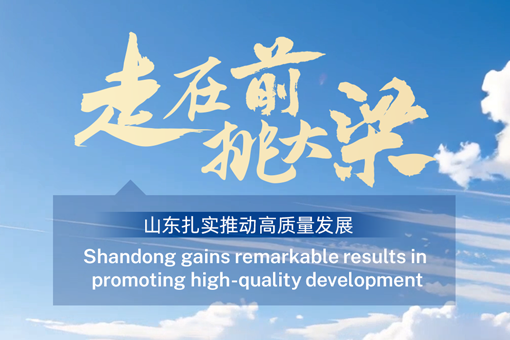Shandong to accelerate world-class ports construction
(chinadaily.com.cn)| Updated : 2021-03-22
Print PrintEast China's Shandong is reportedly planning to speed up its construction of world-class ports, with the province home to Shandong Ports Group, based in the port city of Qingdao and one of the world's biggest ports operators.
On March 20, the Shandong government issued Opinions about Accelerating World First-class Sea Port Construction, outlining the positioning, solid foundations and optimal function of the province, to expand cooperation and deepen reforms, so that its ports in 2025 will reach world-class levels and that in 2035 its major ports will be leading international ports.
A group of 17 suggestions for the implementation of these goals are as follows:
High-standard, scientific establishment of first-class seaport development
1.Strengthening principles: Drafting plans for guidance
Mid-term and long-term programs for Shandong's coastal port development are set to develop a world-class port ecosystem -- focusing on top-flight facilities, technology, management and services, amongst others -- to promote the transformation of a hub port of trade and finance with fully functional, efficient services and outstanding features.
2.Strengthening goal-oriented targets
By 2035, the development level of coastal ports in Shandong will be greatly improved and major coastal ports will become world-class ports.
Shandong will lay a solid foundation for the development of smart, green and safe ports.
3.Making ports more intelligent
Shandong will expand the application of cutting-edge port technologies such as 5G, Beidou Navigation Satellite System and the internet of things. By 2025, the operation of specialized dry bulk cargo terminals above 50,000 tons will basically all be automated.
4.Promoting green development of ports
Shandong will build a clean energy system for ports and actively roll out hydrogen-powered ports in China. By 2025, clean and new energy being used in ports will account for 60 percent of overall energy consumption.
5.Ensuring the essential security of ports
The dual prevention system of hierarchical management and control of work safety risks and the detection and response to potential dangers will be handled, with high-risk workplaces to be automated and unmanned. Potential dangers will be checked regularly and major hidden dangers will be identified and removed in a timely manner.
6.Coordinating the use of port land and sea security
Shandong will accelerate the utilization of land granted by government and the disposal of idle land in accordance with regulations and strengthen the protection of land used for key projects involving seaport construction.
Improving the functions of ports and striving to upgrade their development levels
7.Enhancing the position of ports as hubs
By 2025, the proportion of container transshipments will reach 18 percent.
8.Enhancing the trade function of ports
Shandong is set to develop its bulk commodity spot trading market, expand the functions of a bulk commodity trading center and develop a Northeast Asia maritime trade interconnection index with international influence by 2022.
9.Expanding port financial services
Shandong will support the Belt and Road Initiative's land-sea linkage development fund and build a high-quality equity investment platform.
10.Promoting port-industry-city integration
Shandong will promote the development of an offshore industrial park, the transformation and upgrading of old port areas and the cluster development of chain industries. It will create integrated development models such as cruise-themed towns and cultural tourism towns. It will speed up support of high-end services and build a green and harmonious space for industry and the city.
Expanding cooperation, accelerating development of a new pattern of land-sea opening up
11.Boosting maritime business
Plans are to establish five shipping business groups with operations in Japan and South Korea, Southeast Asia, Middle East Asia, India and Pakistan, Europe and the US. By 2025, the number of foreign trade routes will have reached 278.
12.Enlarging continental shipping business networks
By 2025, a total 50 inland ports are expected to have been built. Shandong will establish a mechanism for cooperation between seaports and the Qilu Eurasian freight trains, as well as expand channels for cross-border cargo distribution and transit transport.
13.Building a golden maritime transport corridor with Japan and South Korea
Shandong will improve the efficiency of China-Republic of Korea international passenger and cargo roll-on/roll-off liner transport, as well as promote the opening of China-ROK land-sea combined transport.
Deepening reform, boosting vitality of internal developments
14.Deepening reforms of integrated ports
The aim is to promote the integration of coastal ports and related resources in the province through capital operations, project cooperation and mixed-ownership reforms -- as well as strengthening the comprehensive development and intensive utilization of river and seaport resources.
15.Implementing cost reductions, increasing efficiency
According to the regulations, seaports in Shandong can enjoy exemption from company income tax, value-added tax and stamp duty and exemptions from urban infrastructure auxiliary fees.
16.Optimizing port service environment
The province will establish a coordination mechanism for port units, innovate its supervision model and strive for a more relaxed visa-free inspection exemption policy. It will also aim to facilitate links for organizing port operations, optimize navigation safety mechanisms and improve the navigation efficiency of ports and waterways. It will also support the operations mode for handling containers on the arrival of container ships.
17.Improving the organization and coordination mechanism
Shandong will establish a coordination mechanism between municipal governments and provincial port enterprises, strengthen strategic cooperation between the government and enterprises, as well as provide tracking services for major projects, so as to form synergies for high-quality port development.

 Xi's Moments
Xi's Moments  Shandong excels in advancing high-quality growth
Shandong excels in advancing high-quality growth  Shaping world-class port services provider for future
Shaping world-class port services provider for future